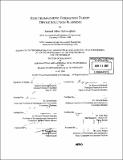| dc.contributor.advisor | Raymond Sedwick. | en_US |
| dc.contributor.author | Schweighart, Samuel A. (Samuel Adam), 1977- | en_US |
| dc.contributor.other | Massachusetts Institute of Technology. Dept. of Aeronautics and Astronautics. | en_US |
| dc.date.accessioned | 2006-03-29T18:46:52Z | |
| dc.date.available | 2006-03-29T18:46:52Z | |
| dc.date.copyright | 2005 | en_US |
| dc.date.issued | 2005 | en_US |
| dc.identifier.uri | http://hdl.handle.net/1721.1/32464 | |
| dc.description | Thesis (Ph. D.)--Massachusetts Institute of Technology, Dept. of Aeronautics and Astronautics, 2005. | en_US |
| dc.description | Includes bibliographical references (p. 325-327). | en_US |
| dc.description.abstract | Electromagnetic Formation Flight (EMFF) describes the concept of using electromagnets (coupled with reaction wheels) to provide all of the necessary forces and torques needed to maintain a satellite's relative position and attitude in a formation of satellites. With EMFF, this formation can be controlled without the use of traditional thrusters. This thesis demonstrates the feasibility of the EMFF system. First three different models for the forces and torques produced by the electromagnets are created, and the equations of motion are developed and described. The equations of motion are determined to be polynomial functions of each satellite's magnetic dipole (which is directly related to the current in the electromagnets). Methods for solving the equations of motion are presented along with examples showing that any desired maneuver can be performed as long as the formation's center of mass is not required to change. An effect of Newton's third law causes torques to be applied to the individual vehicles in a direction opposite to the formation's angular acceleration. Reaction wheels are used to absorb the angular momentum. Next, the thesis describes methods for distributing the angular momentum evenly among the satellites. Finally, the additional challenges of operating in low Earth orbit are addressed. These include operating in the Earth's gravitational field (including the J₂ disturbance), and operating in the Earth's magnetic field. The latter is a mixed blessing due to the large disturbance torques produced from the Earth's magnetic field. However, it is shown in this thesis that it is possible to control and utilize these disturbance torques. | en_US |
| dc.description.abstract | (cont.) In fact, the torques from the Earth's magnetic field can be used to remove excess angular momentum built up on the satellite reaction wheels. Overall, this thesis proves that EMFF can be used to control the relative position and attitude of satellites flying in formation. | en_US |
| dc.description.statementofresponsibility | by Samuel Adam Schweighart. | en_US |
| dc.format.extent | 327 p. | en_US |
| dc.format.extent | 14765601 bytes | |
| dc.format.extent | 14786933 bytes | |
| dc.format.mimetype | application/pdf | |
| dc.format.mimetype | application/pdf | |
| dc.language.iso | eng | en_US |
| dc.publisher | Massachusetts Institute of Technology | en_US |
| dc.rights | M.I.T. theses are protected by copyright. They may be viewed from this source for any purpose, but reproduction or distribution in any format is prohibited without written permission. See provided URL for inquiries about permission. | en_US |
| dc.rights.uri | http://dspace.mit.edu/handle/1721.1/7582 | |
| dc.subject | Aeronautics and Astronautics. | en_US |
| dc.title | Electromagnetic formation flight dipole solution planning | en_US |
| dc.title.alternative | EMFF dipole solution planning | en_US |
| dc.type | Thesis | en_US |
| dc.description.degree | Ph.D. | en_US |
| dc.contributor.department | Massachusetts Institute of Technology. Department of Aeronautics and Astronautics | |
| dc.identifier.oclc | 61752828 | en_US |

